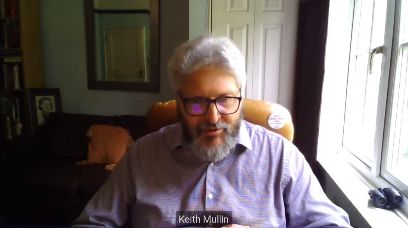KEITH MULLIN, KM CAPITAL MARKETS: CHRISTA, I’D LIKE TO GET YOUR THOUGHTS ABOUT DATA QUALITY. THE EU TAXONOMY AND GREEN BOND STANDARD HAVE BEEN MENTIONED THROUGHOUT THE DISCUSSION, WE ALSO HAVE THE SUSTAINABLE FINANCE DISCLOSURE REGULATION AND THE PROPOSED CORPORATE SUSTAINABILITY REPORTING DIRECTIVE TO REPLACE THE NON-FINANCIAL REPORTING DIRECTIVE. THERE IS A MOVE TO MAKE SURE THAT COMPANIES DISCLOSE, AND DISCLOSE IN A MATERIAL FASHION. HOW WOULD YOU SUMMARISE THE QUALITY OF DISCLOSURE TODAY? DO YOU HAVE ENOUGH? IF YOU DON’T, WHAT DO YOU DO ABOUT IT?
Christa Clapp, Cicero Shades of Green: If I had to put just one word on it, I would say “patchy” at best as an overall comment about where the market is. Of course, we work with some issuers that are very well prepared and have done their homework. That makes our job easier, and their job easier too. But we have found, particularly with the Taxonomy as we look at some preliminary alignment pieces, that there seems to be a little bit of a misperception in the market that Taxonomy alignment is simply a matter of data on the environment thresholds for the activities.
But the Taxonomy has three requirements for alignment: meeting the environmental threshold; not doing significant harm on the other environmental and sustainability criteria; and meeting the minimum social safeguards. Those are three checks that we need to go through with an issuer. And often they’ve prepared, maybe, the first step, and not the others.
And it does require a different level of data, especially for not doing significant harm, and a level of interpretation on our side, as well, to make sure that we’re striking a balance between what is necessary to know in terms of avoiding negative environmental impacts, but, at the same time, making it reasonable for issuers to come to market. That’s a challenge of usability as we start implementing the Taxonomy that we all have to work through.
As I said earlier, I think the answer is not more data, it’s the right kind of data. We need to understand the data. We need to understand, for example, that a new building is not being built with materials that have a lot of life-cycle emissions. That would be an obvious example.
I think we will have an adjustment period, and I don’t think there’s a way that issuers immediately can be prepared for that, and we’re trying to incorporate that analysis in all our products, and I know investors are also preparing. There’s just a big challenging period right now where we’re all after more information, but we’re after the relevant type of information.

KEITH MULLIN, KM CAPITAL MARKETS: THERE ARE SOME QUESTIONS FROM THE AUDIENCE THAT I WANTED TO THROW OUT: WITHOUT CARBON REDUCTION, NOTIONS OF SUSTAINABILITY ARE FUTILE SHORT-TERMISM. HOW DOES THE PANEL RESPOND TO THIS?
Christa Clapp, Cicero Shades of Green: Certainly, we agree, and that’s embedded in the method that we use, Shades of Green, where a dark green rating from us on a bond indicates that the use of proceeds is targeting activities that are generally in line with the Paris Agreement, that is to say across all sectors around net-zero emissions by mid-century.
There’s some interpretation around what net-zero means, but that’s the general direction, and we think it’s very important, especially for infrastructure investments that are made today, that we get that alignment right. That’s the bedrock of our approach. When we review sustainability bonds or sustainability-linked bonds, we don’t deviate from that green aspect. We think that climate risk is the most material risk that we know from the science of sustainability aspects, so that’s our number one concern as well.
Frank Richter, NRW.Bank: I would agree, as well. Keeping global warming in line with the Paris Accord – for us that means close to 1.5 degrees – is the most relevant target we have in mind. If we come to the market with a green bond, we try to allocate as much as possible to CO2-saving loans and projects. Renewable energy is the most relevant, followed by renovation and upgrading of the housing stock, and green transport as the sectors that contribute to this.
Alban de Faÿ, Amundi: When we look at green bonds, we also look at the overall strategy of the issuer, taking into consideration an assessment regarding their 2-degree trajectory. We have also built some dedicated strategies around the Paris Agreement. In this case, if we do not have a very clear carbon-reduction target from the issuer assessed by an external provider like the Science-Based Targets Initiative, we do not invest in this kind of issuer. We have additional information beyond ESG ratings that helps us to look at the issuer and the assessment of its clear carbon reduction targets.
KEITH MULLIN, KM CAPITAL MARKETS: ANOTHER AUDIENCE QUESTION: DO YOU AGREE THAT GREEN BONDS/SLBs SHOULD ENJOY LOWER ISSUANCE COSTS TO PROMOTE ISSUERS’ CONTINUOUS AMBITIONS ON CLIMATE AND ENVIRONMENTAL IMPACT?
Dominika Rosolowska, EIB: I won’t comment on sustainability-linked bonds specifically as this is not an area that we are active in, but perhaps just a general comment on the pricing of green bonds. One point is that pricing of a bond in the primary market is, in general, impacted by a series of factors, and I think it’s quite difficult to foresee a priori a discount, or premium, when you come to pricing.
However, of course, there is this supply-and-demand dynamic in place in the case of green and sustainability bonds. This might have an effect on pricing – in the primary market, first of all, where you may see issues that are heavily oversubscribed, and then in the secondary market. That secondary market performance may be used as the basis for pricing new primary issues.
KEITH MULLIN, KM CAPITAL MARKETS: GIVEN THAT FINANCIAL INSTITUTIONS ARE A REASONABLY BIG SEGMENT OF THE ESG-LABELLED UNIVERSE, WE HAVE HAD INSTANCES WHERE BANKS ISSUE GREEN BONDS TO FINANCE GREEN ASSETS BUT THEY MAY ALSO BE FINANCING ACTIVITIES THAT ARE DISTINCTLY NOT GREEN. WE HAVE A QUESTION HERE: HOW IMPORTANT IS IT THAT THE ISSUER SHOWS A TENDENCY TO BECOME GREENER, OR IS A BOND BEING LABELLED GREEN SUFFICIENT?
Christa Clapp, Cicero Shades of Green: It’s important to understand the direction of the institution. That’s why we have embedded the governance assessment that I mentioned before, which looks at the overall direction of the institution and how they might implement that. It’s even more important for a financial institution because they are one step removed from those green activities. They provide loans to companies that are then implementing those activities.
We need to understand what recourse they have if the company isn’t following through, or how they filter those companies for risk. It’s absolutely important. I think the Taxonomy and new regulations at the EU level help provide some more certainty in that direction.
Alban de Faÿ, Amundi: Financial institutions have a key role to play in financing the energy transition. That’s why the sector can be placed in a green bond strategy. When we look at a green bond, we are looking at the overall strategy of the issuer. We pay attention to make sure that we do not favour a bond with higher transparency when an issuer displays appetite for financing a new coal power plant.
We had a case where we invested in a green bond from an Indian bank, and the bank decided to finance a new coal power plant. We engaged with the issuer and, in the end, we sold our bond because the issuer did not heed our comments. Clearly, we have a key role to play to be sure that we avoid some greenwashing in this area.
Tessa Walsh, IFR: Financial institutions that lend to projects that are not green doesn’t link to the green assets financed by green bonds, but there are knock-on effects on reputation. Some have suggested that this should have an impact on their green bonds.

On the “greenium” or green premium, we may see some distinction in that as green companies become greener, their greenium actually goes down as they become more environmentally sustainable. And we may also see a distinction in greenium as a result of deals that comply with the tighter regulations of the Taxonomy and the Green Bond Standard, and then the broader universe, as well. There are a lot of very interesting distinctions being drawn.
KEITH MULLIN, KM CAPITAL MARKETS: I WOULD LIKE TO ASK EACH OF OUR PANELLISTS TO MAKE A CLOSING STATEMENT HIGHLIGHTING OPPORTUNITIES AND CHALLENGES THAT YOU SEE, YOUR KEY AGENDA TOPICS; AND FROM THE ISSUERS, HOW MUCH MORE MIGHT WE SEE YOU ISSUE IN LABELLED FORMATS THIS YEAR. AS THE WORLD MOVES, HOPEFULLY SOON, BEYOND THE COVID-19 PANDEMIC, WHICH HAS GIVEN RISE TO SO MUCH MORE LABELLED ISSUANCE, HOW DOES THE PANEL THINK THE COMPLEXION OF THE ESG-LABELLED MARKET MIGHT CHANGE AS WE GET BACK TO A FRAMEWORK OF NORMALISATION?
Dominika Rosolowska, EIB: The key development that we are facing, especially in the European Union is the roll-out of the Taxonomy and the upcoming EU Green Bond Standard. From our side, and what I’ve been hearing from the other issuers on the panel, one does not need to wait until the final version of this legislation is rolled out. There are already steps that market participants can take, gradually adapting their practices to what is coming. This is an opportunity for issuers and for the market in general and something that we are striving to promote.
Speaking about how active we expect to be in the green and sustainability bond market. I think the fundamentals are there for us, as an institution. We had our Climate Bank Roadmap 2021–2025 published last November where, essentially, we committed to raising the volume of new environmental lending to half of our overall lending by 2025. And, of course, at least part of this environmental lending could be eligible for our Climate Awareness Bonds or Sustainability Awareness Bonds.
However, how much and how this translates into our funding depends on our capacity and the speed with which we are able to map this lending according to the framework devised by the EU Taxonomy Regulation. In a way, this is our KPI: the extent to which we are able to increase our funding depends on how we are able to map our lending according to this framework.
Another factor supporting our issuance endeavours is the independent review of EIB’s Climate Awareness Bond activity by our independent evaluation experts. Their Evaluation Report, available on our website, suggests that we continue with our issuance practice, demonstrating the early applicability of the Taxonomy Regulation and the EU GBS. Following this advice, we’ll strive to perform this role and be an active issuer in the market, be it on the CAB and the SAB side.
Ralf Berninger, SFIL: In terms of lending for green and social investments, we expect strong demand. We have a huge public healthcare investment plan in France, and we expect to finance a significant share of that. Also, we have a huge public investment plan for energy transition. A large share of that is going to be carried out by local authorities, so again, we expect to contribute significantly to that. We expect to be an active green and social bond issuer, as well, next year.
As for the overall market, what we’re feeling is that the focus is shifting a little; we’re getting a more standardised green product with the Taxonomy and Green Bond Standard. The focus is shifting a little bit, and a much closer look is now taken at issuers’ overall sustainability strategies. We feel that’s going to be a key topic for differentiation for the year ahead.
Christa Clapp, Cicero Shades of Green: We’ve seen increased interest in reviews for the green and sustainability products that were quite steady and growing throughout Covid. We feel that this is an issue that’s here to stay, that sustainability is not just a trend, but rather we’re shifting this huge agenda. And I think the EU legislation is also showing that and pushing harder on disclosure.
The key challenge for us, and I think for issuers too, is this space where we’re pushing really hard on disclosure regulation, and environmental regulation has a little bit of catch-up to do. It’s great to see so much attention and activity in the financial sector. It would make our lives easier, and issuers’ lives easier, if we had stronger climate change legislation and environmental regulations on efficiency in buildings etc at a national level. We’re hoping that catches up. But this momentum is here to stay, I think that’s the message we’ve heard loud and clear.
Frank Richter, NRW.Bank: For me, the most important takeaway for the next couple of months is that we should have an eye on standardisation. I’m quite happy to see that the European Commission is taking the lead. We have already heard a lot about the Taxonomy and Green Bond Standard. I’m totally with Dominika that it is important to move and not to wait until we have the final agenda in front of us.
It’s important for issuers, and I encourage everybody to enter the market to move and to contribute to the Paris Accord. What we should keep in mind, as well, is that we should expect further environmental targets to be part of the Taxonomy before year-end. That will broaden the asset categories available to be refinanced by green bonds. On the other hand, I’m also curious to see what will be behind the social taxonomy, which would give it an additional push into the social bond market.
Alban de Faÿ, Amundi: We are very happy with developments in the fixed income market but my message is to keep in mind that it would be good if issuers kept their instruments simple. We like pure use-of-proceeds green bonds and social bonds. It’s more complex when you mix social and green projects, like sustainability bonds. We have appetite for green and social bonds, and we support the development of SLBs.
And one more time, keep it simple. Don’t use a lot of KPIs; keep the message very clear, and we’ll be very happy with that. And avoid coming to the labelled market just to reduce issuing costs in basis points. That is not the right motivation.
Tessa Walsh, IFR: I think with the level of issuance that’s coming, we expect to see a little more focus on the green market, perhaps, than the social market as the Covid crisis, hopefully, recedes. Although, at the moment, that’s not necessarily a given.
There’s a very interesting debate around the appropriate instrument for transition, whether that’s going to be sustainability-linked bonds, as it does appear since they’re gaining in popularity over the transition bond product, although that remains to be seen.
On the Taxonomy and Green Bond Standard, it’s going to be very interesting indeed to see how that plays out, and if we’ll see new differentiations, perhaps, in terms of cost or pricing. Lots of different things to look out for, but the market does feel very strong, and it’s certainly tracking towards new records, so that’s good news.
KEITH MULLIN, KM CAPITAL MARKETS: THAT’S A GOOD NOTE ON WHICH TO END OUR SESSION. THANK YOU TO YOU ALL FOR YOUR TIME AND INSIGHTFUL COMMENTS.
To see the digital version of this report, please click here
To purchase printed copies or a PDF of this report, please email gloria.balbastro@refinitiv.com


